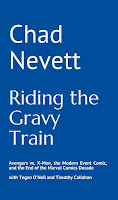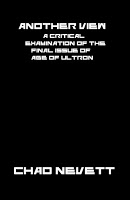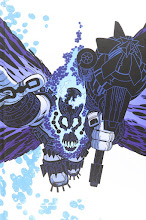 The Big Fat Kill by Frank Miller. (1994-1995.)
The Big Fat Kill by Frank Miller. (1994-1995.)It's hard to read this book without thinking of the film adaptation. I don't have the same problem as much with The Hard Goodbye or That Yellow Bastard, because some of Miller's visual problems from A Dame to Kill For show up here. The lack of clarity in places makes it easy for Jackie-Boy to become Benicio del Toro; for Dwight to become Clive Owen... then again, I really dug the film adaptation of The Big Fat Kill, my favourite of the three stories in the flick. It's a fluffy story that works well on the screen, less so on the page where Miller's pacing isn't 100% on.
While rereading this, I tried to figure out the pacing of the story based on chapter breaks. I assume the breaks coincide with issue breaks, but given that the chapters of the first two stories didn't line up with their serialisations, I won't assume -- though, given the breaks, that's the only thing that makes any sense. Early on, it seems like Miller just hit a page number and said "Alright, I'll pick this up next issue..." It's not quite that bad really, but it's not far off. The first chapter ends with Jackie-Boy and his crew in Old Town, about to get themselves killed, Dwight just held back from interfering by Gail. It's not a bad place to stop and pick things up, but it's a quiet place. It's a lull. There's a rising tension as we wait for the kill and there's an appeal in that, but it just strikes me as odd.
Then again, you don't often see the anticipation break. Building up to something and, then, it's come back next time where the tension has the be rebuilt somewhat. Usually, it's more a cliffhanger. This is subtler and not as effective because, as I said, Miller then spends a few pages at the beginning of the next chapter rebuilding the tension that he spent half the first issue building. It's a long, leisurely build.
The payoff isn't what you'd expect as Miller plays it up for laughs. Crew members are skewered by Miho's blades, while another's head is chopped off, sent flying, bouncing right in front of a freaked out Jackie-Boy frantically searching for his cut off hand. Miller builds up to something awful and delivers absurdist comedy. The real payoff comes after the killing when Dwight finds Jackie's badge.
The payoff is the best sequence of the book and is built in the false payoff scene with the rumbling of thunder that tips Dwight off to the idea that something isn't right. Dwight searches Jackie's body for cash and he finds the 'atom bomb' as he puts it. Full page of thunder with a giant BOOM! sound effect. Two-panel page where one panel is the rain starting to fall and the second is the downpour in action. Then he drags it out over another few pages as Dwight talks around the badge, talks about what it means, how they're all fucked, etc. until he reveals that it's a police badge and Jackie-Boy just isn't any cop, "HE'S A COP. DETECTIVE JACK RAFFERTY. 'IRON JACK,' THE PAPERS CALL HIM. / A GOD DAMN HERO COP."
I do love that reveal. Jackie-Boy is a cop -- and not just any cop, but a hero cop, the sort of cop that could be the star of one of these books. I almost wish the book ended there, because it doesn't get any better than that reveal. That's the climax of the story, the ultimate payoff/joke. Everything that follows feels like work, like necessary mechanics, like going through the motions. Entertaining and fun, sure -- some cool scenes with great visuals, yeah -- but, the reveal of Iron Jack? That's some good shit.
Something I don't like is how Jackie is drawn. Miller uses a lot of blocky lines with lots of contrast for him. He looks generic and blank, which is why del Toro fills in for him pretty easily. Even after he's been killed, his look is one that puts me off.
Dwight, on the other hand, is in full superhero mode in this story. A protector of women, he has his jacket that's like a cape... He's trying to atone for the murder of Damien Lord, Ava's husband that he killed in cold blood, tricked by her... but I never get the feeling that that matters. Miller pays the idea some lip-service and moves on, preferring to focus on the situation Dwight's landed himself in.
Not sure what to make of Dwight's interactions with the girls of Old Town. Obviously, the women like being in charge and running things, and they resent Dwight... but he's right. His plan is the right one and they fight him on it, and they nearly fuck it up, while also supporting him by sending Dallas and Miho to the tar pits after him. Even in A Dame to Kill For, I've been struggling with this relationship. Miller likes his strong, powerful women -- his warrior women -- but they always seem to need some male figure to gather around and listen to. It's weird.
Dwight, as a character, is maleable. I'm not sure he has a fixed position. He shifts from confident to panicked easily. He's very competent, but also a bit of a loser. Why does he choose Shellie over Gail? That's a topic that Miller talks around a lot, but never really addresses. It's also one of the more complex parts of his character, so it's one that interests me...
The Big Fat Kill also includes a scene right at the beginning of chapter five regarding the Spartans that Miller would do 300 about. It's an odd page, because we actually see the Spartans in the Hot Gates -- Miller breaking from the world of Sin City visually. He doesn't do that anywhere else (not including the hallucinations in Hell and Back, but that's different). It's little things like that that remind you how much of this is driven by the idea of 'cool shit Miller wants to draw.' The Tar Pits are an excuse to draw dinosaurs... the women of Old Town are hot babes in skimpy clothes... the Spartans are Spartans... the pacing is relaxed, the pictures are big... it's a breezy, fun read.
Tomorrow, That Yellow Bastard.






